Vesuvius in a Motorhome
Dave the motorhome is huffing and puffing, holding steady for night in a cafe car park (N40.819626, E14.412400), 700m up Mount Vesuvius, looking out into the Bay of Naples as though we’re frozen in time, landing in a plane. The dark cold night lit up like a frozen firework by the city and towns below. Earlier we could see the islands of Capri, Ischia and Procida. It’s stunning, difficult to take in.
Our parking spot last night was a good one, we woke a couple of times with cars turning in the circle behind us, and with the cold seeping into Dave through his windscreen. We have silver screens which slide into sleeves above the single-glazed cab windows, but having them fitted means we can’t drive off without going outside, limiting our getaway potential in case of trouble (which we’ve never had, touch wood). We’ve got them on tonight though, as it’s going to get well below freezing up here we think, although the BBC says a minimum of 2 degrees.
Locals parking beside us to hit the beach for a morning jog, or to sit and shoot the breeze on the wall along side Dave, shook us awake. Pulling back the curtains the sun was climbing above the cliff alongside, bouncing off the sea and hastening our escape from Dave. Charlie loves the beach, and in the morning sunshine the three of us strolled along, eyes turning from the blues of the sky and ocean to the beige mountains behind. In between, tired flaked-painted rusting buildings stand waiting for the storm season to pass, doors of changing rooms removed and plastic boats tied up. If I were dropped here with no idea of where I was, my first guess would have been South America. We were on the cusp of the mezzogiorno, the Italian South, which has a reputation for enduring poverty.
Heading off, we quickly spotted a busy petrol station, selling diesel for €1.67 a litre. We drove past, spun around at the roundabout and back in. This many locals must mean something, and we needed fuel to get down beyond Naples. After about 5 minutes waiting for someone to move from the self service diesel pump, a chap wandered over and asked ‘gasoil?’ ‘si?’ ‘kaput’. No worries, we reversed and added ourselves to the serviced pump queue, wondering why no-one bothered to pop a sign up. The chap filled us up as the queue built up, accidentally snapping off the plastic diesel surround (I’ve snapped it twice – it just glues back on) and we were away. For all of 5 minutes.
Almost as soon as we headed off we spotted signs for the Minturnae ruins, explaining why a long and crumbling aquaduct ran past the petrol station. Entertaining the guardians we wheel-spun Dave up a steep cobble entrance to the car park and pulled into the part reserved for those with kids (we think). €5 a piece didn’t feel too steep and we spent a good hour or two wandering the place alone, one of the old chaps running the place unlocking the museum for us. Imagination is a handy commodity in these places, but the restored theatre and the worn, rutted stones of the Via Appia (a 2300 year old military supply route which had linked Rome with Brindisi on the west coast) were easy to take in.
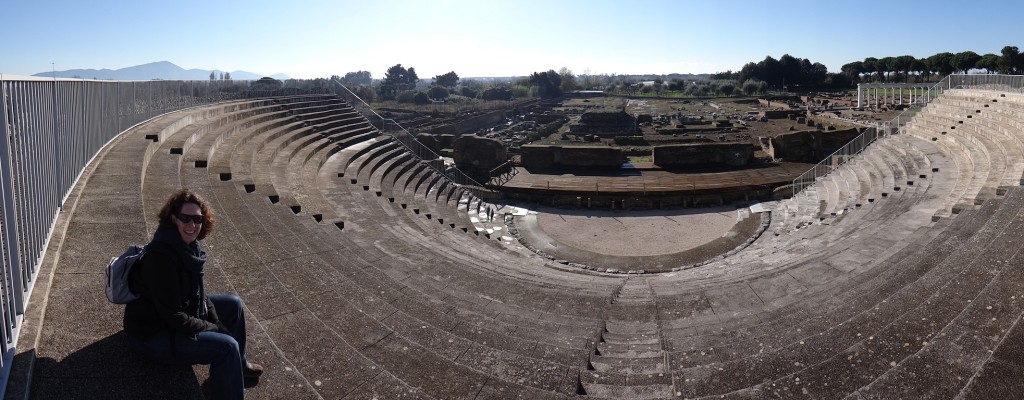
Minturno theatre. Restored, but it felt wonderful to sit on it and look out over the small town below, what was left of it of course!
The road south took us across a broad plain, edged in by mountains. Lifted up a few meters from the damp ground to either side, we had a good view of the surrounding fields and towns. To be honest, the place was a pretty uninspiring affair, buildings built with the imagination of a tight-fisted accountant in a hurry. The standard of driving seemed to drop a little further too, reminding me of Morocco, but with the vehicles driving twice as fast. Apart from a few ‘snap yer wheel off’ holes, and plenty of breaking up sections, the road was OK. We took our friend’s advice to use the toll autoroute to bypass Naples, setting us back a whole €2.10. At the toll booth and traffic lights beyond men stood trying to sell tissues and balloons, good natured to us and easily ignored. A couple of ladies ‘waiting for a bus’ at the side of the road reminded us of southern Spain.
The run up the side of Vesuvius was painful. It appears there is an easy route, and a fair few less easy ones. We drove back and forth at the base of the volcano peering up Dave-wide cobbled streets before finding one reasonably wide. At least it started that way, sides compressing in and steepening into first gear territory. Switchback after switchback pulled us slowly up from the sea into the sky, as a familiar shooting pain in my shoulder requested my attention. Eventually we found the place, a small car park, alongside a cafe, half full of wild dogs.
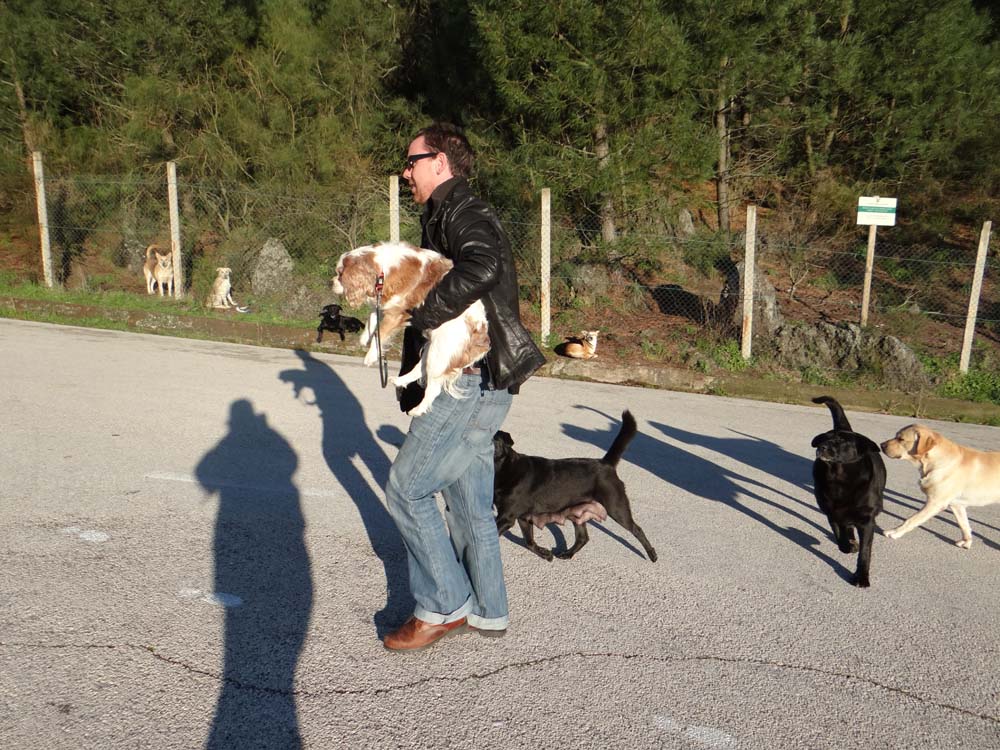
Dog walking on Vesuvius. The wild dogs stayed away, these were the cafe-owner’s dogs, some of them at least.
The couple running the cafe pounced, doing a fabulous sales job on us, a soft one. The lady told us about her father who’d run a cable car up the mountain for over 30 years, ever since witnessing an eruption as a teenager in 1944. They showed us seven tiny black Labrador pups in a space behind the cafe, and talked us through a raft of photos in a Vesuvius book, explaining that the cable car was supposed to be replaced with a funicular, but Greenpeace had halted the plan, and now buses run tourists up and down the mountain side. We listened as intently as we could when you know you’re being pitched to, and bought the book for €10 – a fair price for a nice book and an incredible place to sleep.
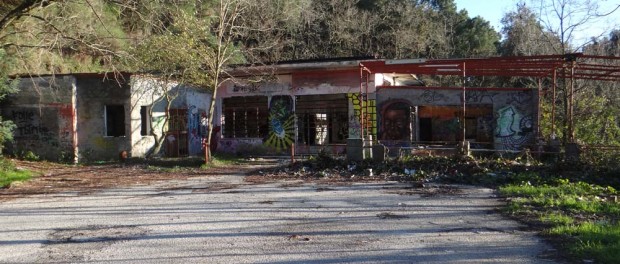
The old Vesuvius cable car station. There is no new one (you have to walk 90 minutes up to the crater). For such an iconic tourist destination, the authorities haven’t made much of it.
We didn’t make the summit/crater rim in time. Although the path should have been open for another half hour, they’d decided to close up early so we came back to the cafe. We’ll have another go at topping out tomorrow, fingers crossed the weather holds!
Cheers, Jay


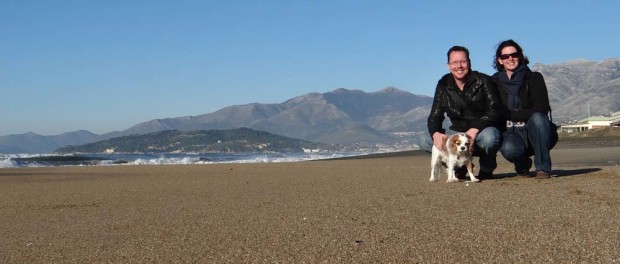
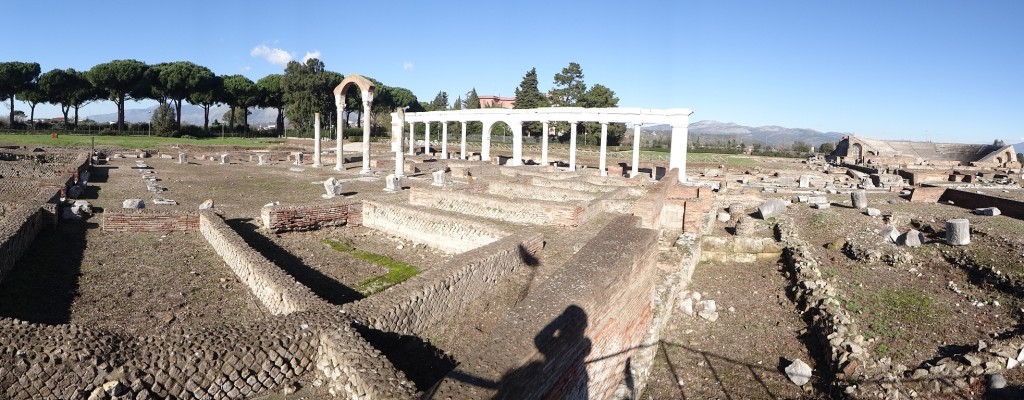
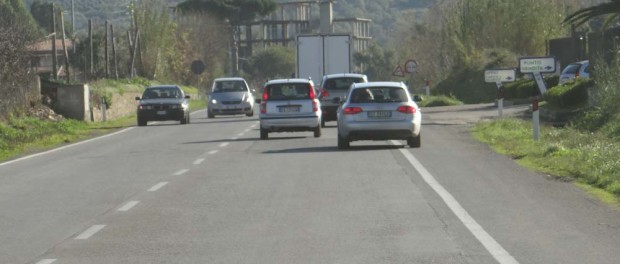
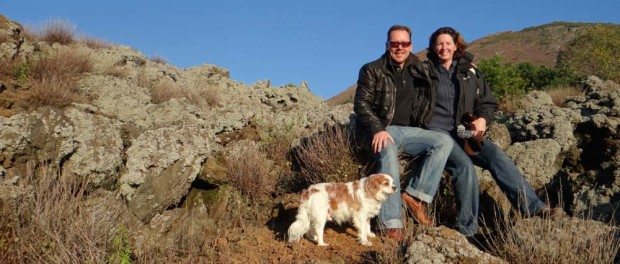
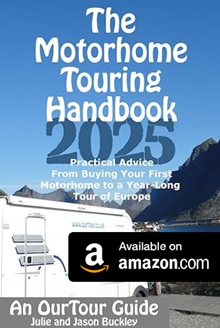
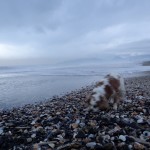
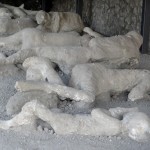
It would appear little has changed since we climbed to the crater some fifteen years back! Still, enjoy :)
Fantastic. Love it, so excited to read today’s blog entry. There is something about Vesuvius that just captures you. I loved looking back over the bay of Naples and the valleys full of lava flow. It’s just so exciting to be on such an iconic mountain. Wait till you get to Sicily and see Etna..it’s magic. Ahh – you guys are bringing back all our memories…imgaine doing all that in a 8.5m autotrail in high season and in 40c – we just love Italy’s volcano’s.
Are you heading along the Amalfi coast when you’ve done Vesuvius? Amalfi, Sorrento, positano and Ravello are all beautiful and worth a look.
Much love!!
Hi Anne
We’re going to set up camp in Pompeii then get the bus and train down the Amalfi coast (no motorhomes allowed!) and into Sorrento and Naples (nightmare roads). Will have a look at the other places too and sus out the best way to get to them. Cheers for the tips. Ju x